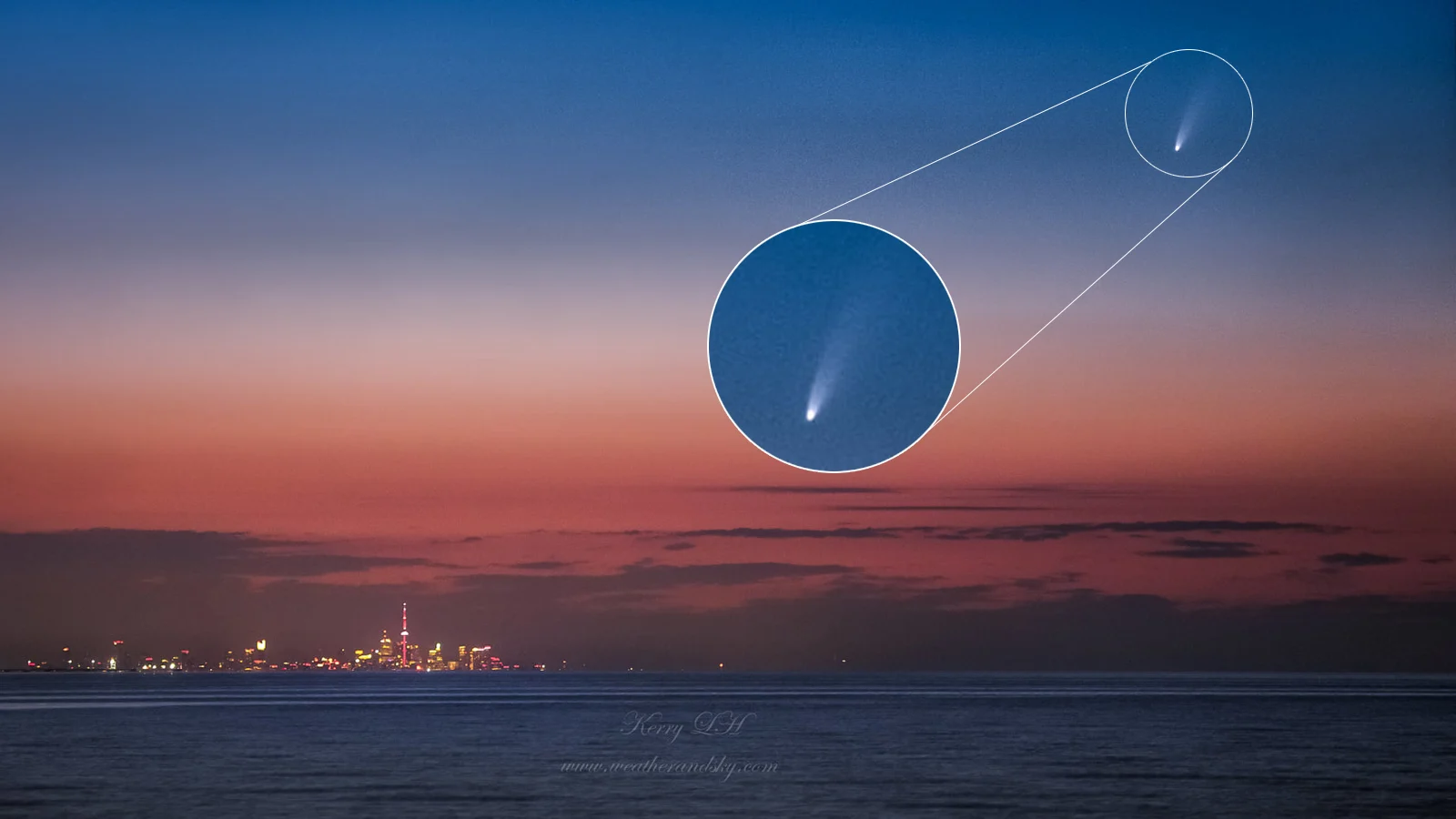
Here's how to see Comet NEOWISE from anywhere this summer
Astronomers have a few tricks to spot this visitor from the outer solar system
Starting in early July, a new comet showed up in the early morning sky, and it looks like it should remain visible in the evening for the rest of the summer.
Comet C/2020 F3 (NEOWISE) was first discovered on March 27, 2020, as it approached the Sun from below the ecliptic plane. Spotted by NASA's NEOWISE space telescope, this comet was found to be on a very long journey. It just spent nearly 3,400 years flying in from the outer edges of our solar system to swing around the Sun!
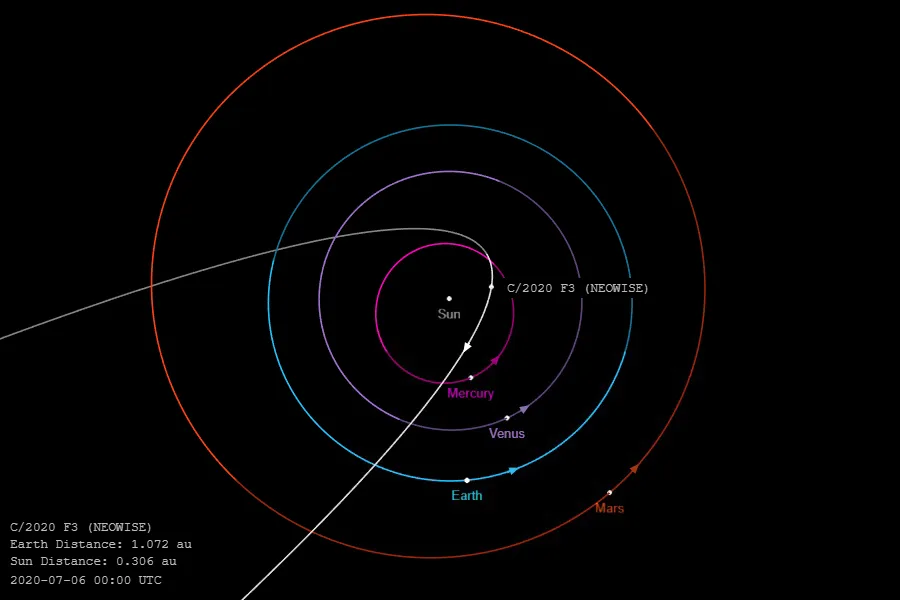
A computer model of the inner solar system shows the path of Comet C/2020 F3 (NEOWISE). Credit: NASA CNEOS
"In its discovery images, Comet NEOWISE appeared as a glowing, fuzzy dot moving across the sky even when it was still pretty far away," Amy Mainzer, NEOWISE principal investigator at the University of Arizona said in a NASA press release. "As soon as we saw how close it would come to the Sun, we had hopes that it would put on a good show."
Now having survived that passage, NEOWISE is flying high above the inner planets on its way back to the outer reaches of the solar system.
Watch below: Have questions about Comet NEOWISE? NASA scientists may have the answers!
Ideally located in space to view from Earth's northern hemisphere, Comet NEOWISE first showed up in the northeastern sky, in the hours just before sunrise.
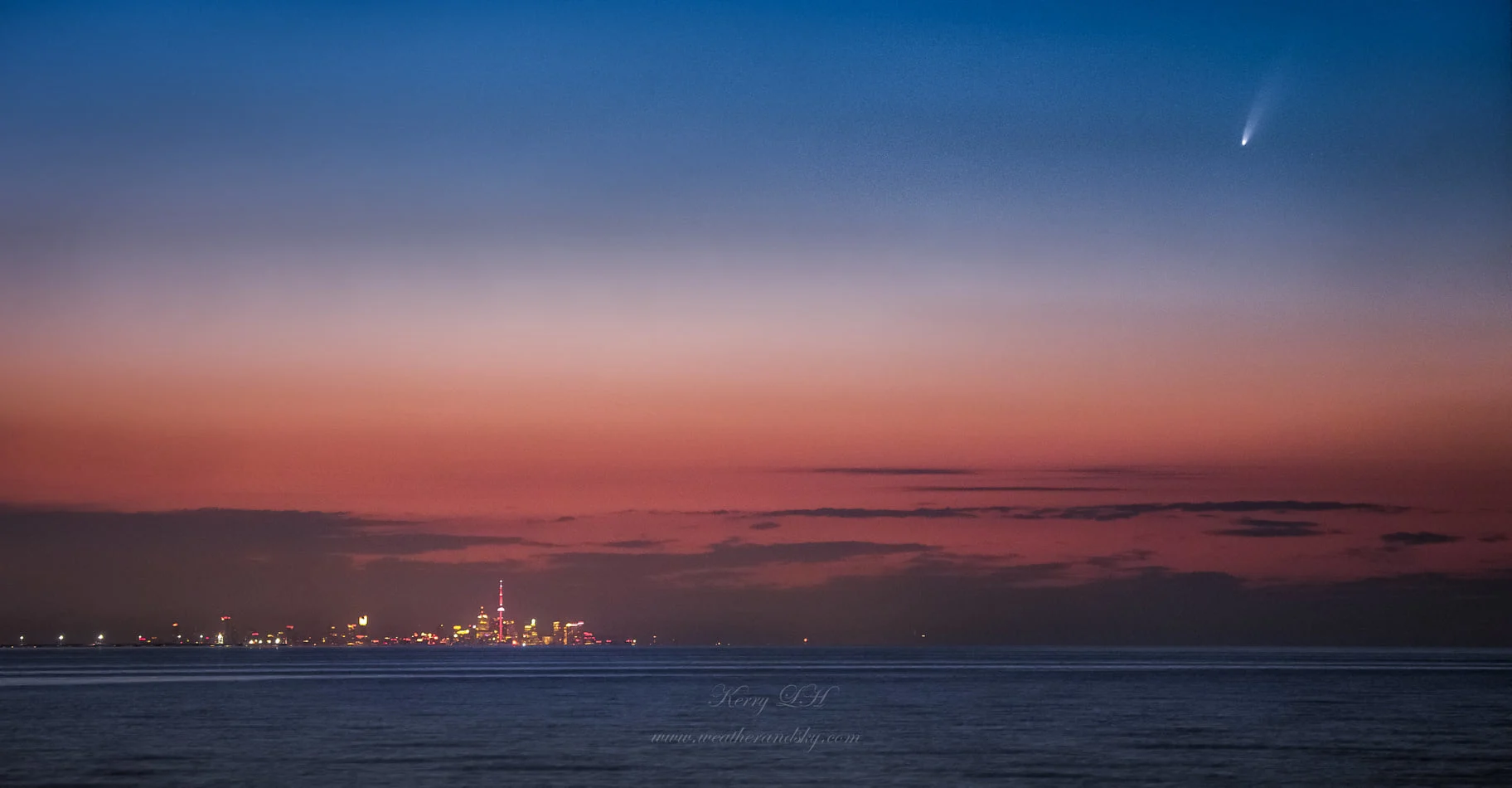
This long-exposure image of Comet C/2020 F3 (NEOWISE) was captured on the morning of July 5, 2020, by Weather Network meteorologist and astrophotographer Kerry-Ann Lecky Hepburn (instagram.com/weatherandsky)
The above image is an idealized view of Comet NEOWISE, of course. According to the astrophotographer who captured it, Weather Network meteorologist Kerry-Ann Lecky Hepburn, the photograph is comprised of several 1-minute exposures. These are all stacked on top of one another using imaging software to enhance the comet's brightness and bring out more of its details.
According to the Comet Observation Database, C/2020 F3 (NEOWISE) is estimated at being around magnitude 1.2 right now. That is so-called 'naked eye' brightness, and brighter than the stars of the Big Dipper or even Comet Halley during its last pass, back in 1986. Be careful, though. A pinpoint source of light at that brightness, such as a planet or a star, is relatively easy to see, even from light-polluted urban areas. Spotting the diffuse coma and tail of a comet at that brightness is more difficult, though. This is especially true with light pollution and if the comet is set against the backdrop of a twilit sky.
Responding to a comment on Facebook, Lecky Hepburn said that when she was capturing her long-exposure images, the comet was faint and difficult to see with the unaided eye. She had to use a technique astronomers call 'averted vision'.
If you have ever spotted something out of the corner of your eye in the night sky, but it vanished when you looked directly at it, you have used averted vision.

This picture of Comet NEOWISE, from TWN's User Generated Content Gallery, was captured from André-J.-Côté Park, in Candiac, QC, on the morning of July 6. Credit: Stephane Pelletier
Basically, this technique takes advantage of the sensitivity of our peripheral vision to spot objects too dim to see directly. Its effectiveness can vary from person to person, and you may need to take some time for your eyes to adapt to the dark to get the maximum effect. Still, looking off to one side, while keeping your attention focused on the comet's location in the sky, may produce results.
For best viewing, seek out a good rural area to watch from, such as the parking lot of a provincial park. If you have a telescope or binoculars, these will make it easier to see the comet, and using averted vision can still help you to hone in on where it is.
MORNING TO EVENING SHIFT
Although visible only in the pre-dawn twilight to start, Comet NEOWISE is now switching things up a bit.
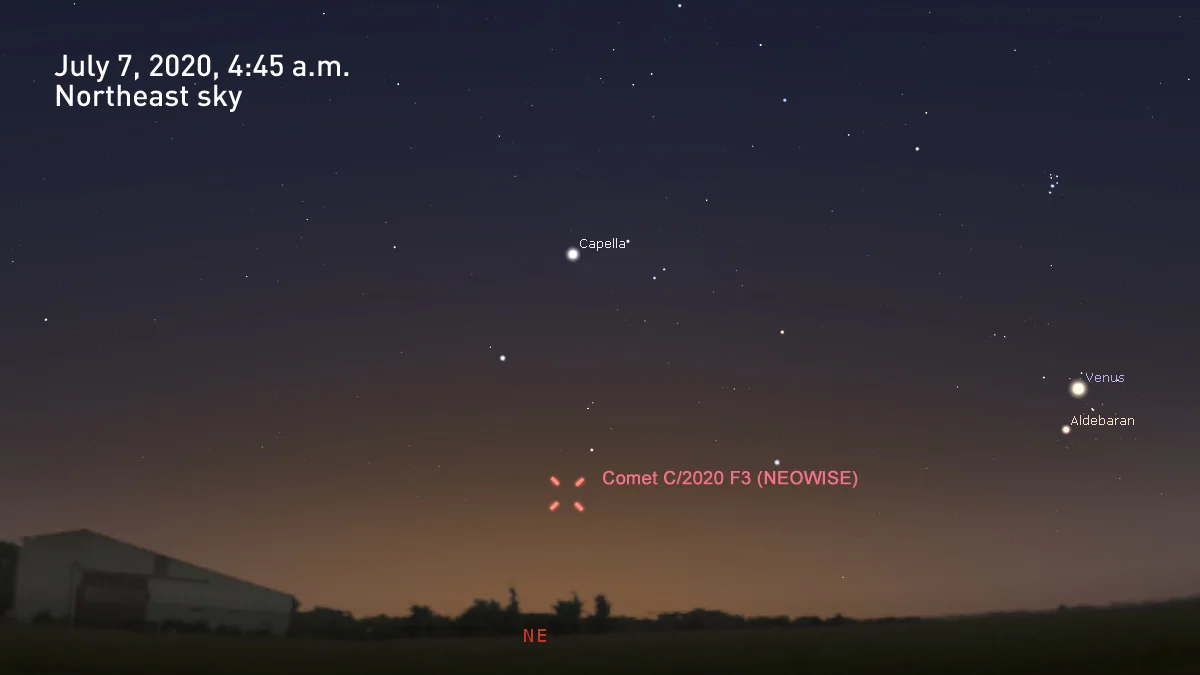
The location of Comet C/2020 F3 (NEOWISE) in the pre-dawn sky on July 7, 2020. Credit: Stellarium/Scott Sutherland
Starting on the night of July 10, even as the comet continues to be visible in the hour or so before sunrise, evening skywatchers also saw it rise above the northwestern horizon after the Sun had gone down.

Comet NEOWISE to the north-northwest in the evening sky, around 10:45 p.m. local time. Credit: Stellarium/Scott Sutherland
As an evening comet, NEOWISE should be easier to see against the backdrop of the darker sky. Its brightness will still diminish steadily in the next few weeks, however, as the comet
Later this month, and into August and September, the comet will leave the morning behind altogether, and remain visible only during the evening, tracking farther into the western sky, night by night.
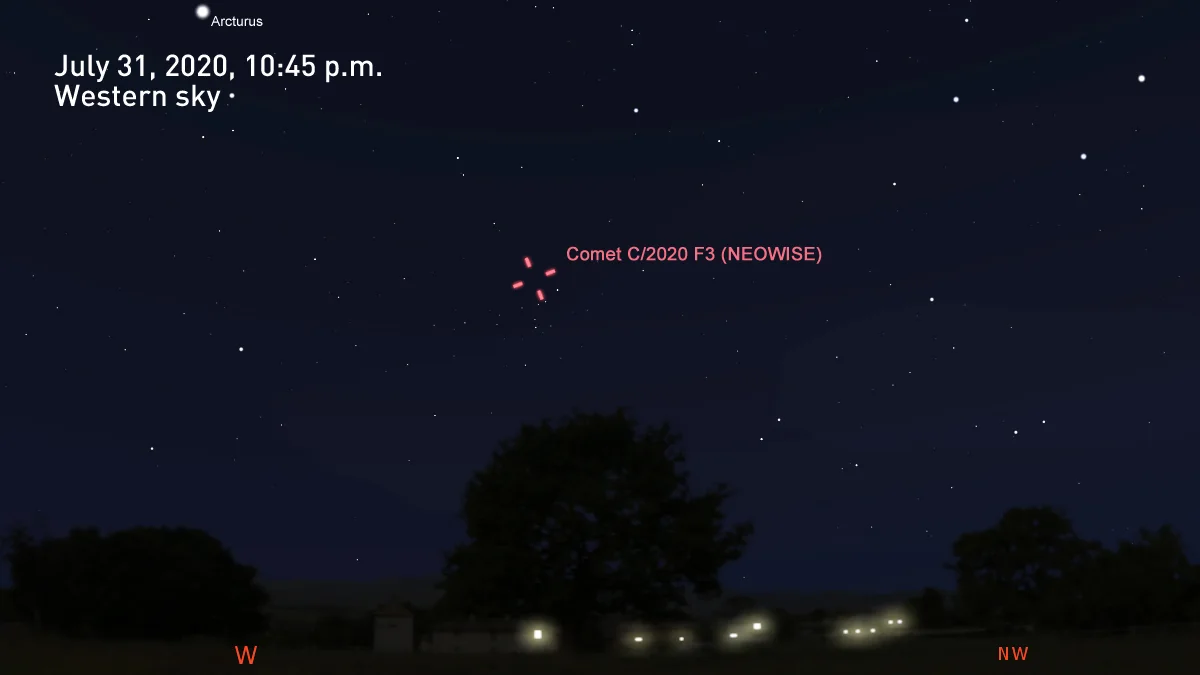
Comet NEOWISE in the western sky, on the night of July 31, 2020. Credit: Stellarium/Scott Sutherland
At the same time, its brightness will continue to dim as it moves farther away. So, a telescope or binoculars are still the best way to view NEOWISE throughout the season.
WHAT IS COMET NEOWISE?
C/2020 F3 (NEOWISE) is what's known as a periodic comet. Essentially, it is a roughly 5-kilometre wide chunk of ice and rock and dust - a 'dirty snowball' if you will. It has been flying around space for billions of years, and likely contains some of the earliest materials to ever form in the solar system.
"From its infrared signature, we can tell that it is about 5 kilometres across, and by combining the infrared data with visible-light images, we can tell that the comet's nucleus is covered with sooty, dark particles left over from its formation near the birth of our solar system 4.6 billion years ago," Joseph Masiero, NEOWISE deputy principal investigator at the Jet Propulsion Laboratory in Pasadena, California, told NASA.
This could be NEOWISE's first trip around the Sun or just the latest of hundreds of thousands of orbits. Either way, when it approached the inner solar system, the increased heat from the Sun began to vaporize the water and carbon dioxide ices at its surface. As these gases streamed out of the nucleus, they carried surface dust with them, forming into a cloud tens of thousands of kilometres wide, around the comet nucleus. This cloud is known as 'the coma'.
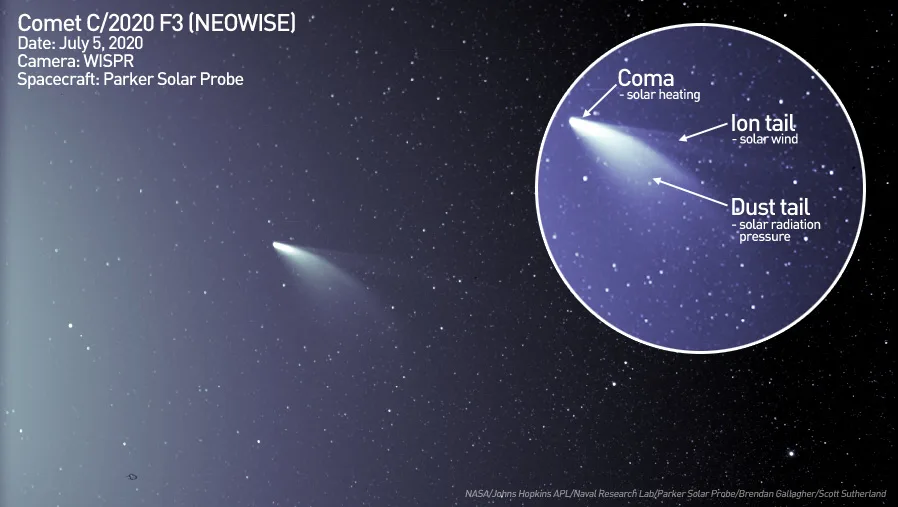
Comet NEOWISE, imaged by the Parker Solar Probe's Wide-Field Imager for Solar Probe (WISPR) instrument on July 5, 2020. The insert shows an enhanced close-up view of the comet, with the different parts labelled. The comet nucleus is so small in comparison to the coma and tails that it would only be a pin-point in one pixel. Credit: NASA/Johns Hopkins APL/Naval Research Lab/Parker Solar Probe/Brendan Gallagher/Scott Sutherland
At the same time, the comet sprouted a pair of tails, as the gases and dust in the coma stream away from the Sun. Why two tails? Because the dust and the gas in the coma react differently to the influence of the Sun.
One of the tails is known as the dust tail. This one is a result of dust particles in the coma being pushed away from the comet by solar radiation pressure. The dust tail tends to be curved due to the particles lagging behind the comet as it moves through space, and it shines brightly as the dust particles reflect the rays from the Sun.
The other is the ion tail or plasma tail. This one is composed of electrically-charged gas molecules from the coma. It forms as these gases are drawn away from the comet by the solar wind - the constant stream of charged particles that originates from the Sun. It always points directly away from the Sun, and we see the ion tail because it literally glows with its own light.
We have at least a few weeks where Comet NEOWISE will be visible in the sky. Those skywatchers with telescopes will likely be able to see this remarkable comet for even longer. Check back here for updates in the days and weeks ahead.
Sources: weatherandsky | Astronomy | Comet Observation Database | With files from The Weather Network
